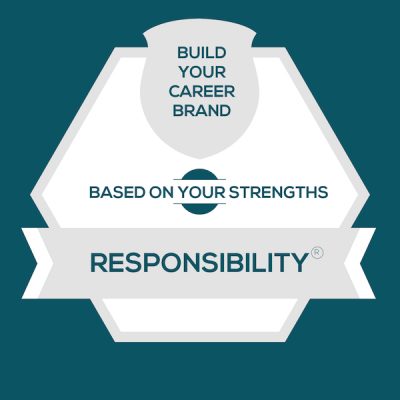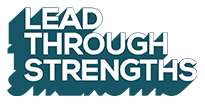Responsibility Strength: Build A Genuine Career Brand
Podcast: Play in new window
Subscribe: Spotify | iHeartRadio | Email | TuneIn | More
 Responsibility Strength: Get Known For Your Talent
Responsibility Strength: Get Known For Your Talent
I get a whole lot of questions about how to align your CliftonStrengths talent theme of Responsibility with your career.
In this series, I break down one strength per post — so that you can add to the insights from your StrengthsFinder report and make a better match between your job and your strengths.
- If you’re exploring this concept as a manager, use this series for career development ideas and even new clues about responsibilities you could give a person with this talent theme so that they can show up at their best.
- If you’re exploring this concept for yourself, use this as a chance to build a reputation for your strengths so that you’re more likely to be given assignments that live in your strengths zone.
Today, the talent theme of the post is Responsibility.
You’ll get three layers to chew on:
- Career Branding
- Red Flag Situations At Work
- Fresh Application Ideas
Career Branding For The Responsibility Strength
Let’s start with career branding. You probably already have a reputation for what you know. If you imagine your resume or your LinkedIn profile, I bet it's full of “the what,” which are things like job titles, skills, knowledge, expertise, or the degree you earned. Now, what’s missing in most of them is "the how,” and this is where your StrengthsFinder talent themes live. This is an overlooked use for LinkedIn, which is not just for job seekers.
I bet you are just like my StrengthsFinder training clients, where you don’t see your teammates and customers every day. That’s why LinkedIn has become so important for career branding. It’s how your teammates, customers, and vendors go look you up before a meeting - to see who they’re about to talk to. And rather than only telling them what you know, you should also give them a peek at how it is to work with you.
Here are a bunch of adjectives to consider using in your career branding efforts and your LinkedIn profile when you lead through the Responsibility strength:
- Trustworthy
- Loyal
- Diligent
- Dependable
- Driven
- Accountable
- Conscientious
- Dutiful
- Promise-Keepers
- Honest
- Service-Oriented
- Committed
- Volunteer
- Word Is Honor
- Responsive
- Owner Of Work
Red Flag Situations When You Lead With The Responsibility Strength
These are the cultures, interactions, or situations that feel like soul-sucking drudgery to someone with the talent theme of Responsibility. They might even make you want to quit the team. So I’ll give you a couple of these to be on watch for — because if they fester, you might get the urge to quit the job or become detached and disengaged at work.
Here are a couple of Red flags for the Responsibility strength (talent theme):
- Chronically Missed Deadlines. If you lead through the Responsibility strength and your team culture is one that is cavalier with deadlines, it will suck the life out of you. To you, your word is your honor, and you expect other people to honor their commitments as well. So when people miss their deadlines and treat it like no big deal, you’ll likely feel like it’s a place where mutual respect is severely lacking.
- Imposed Urgencies. You’re conscientious and dependable. You plan things out diligently so that you can keep your promises. So when other people constantly blow up your day with their lack of preparation, you're likely fuming. If you work in a place where people tend to launch their hand grenades at you — which puts you at risk of not keeping your promises, this will suck the life right out of you.
3 Fresh Application Ideas For The Responsibility Strength
These are ways to apply the talent theme of Responsibility at work , even when the job duties on the team feel pretty locked in. If you’re exploring this concept as a team manager, be sure to have a conversation around these ideas. You’ll both be able to come up with places to apply them.
For someone who leads through the Responsibility strength, put the talent to good use with one of these options:
- The long haul. When you need someone who will consistently chip away at a project over time, assign it to someone with Responsibility. They are self-starters who will diligently follow it through the long term.
- Trust. When you need to hand something off to someone you can trust, assign those responsibilities to someone with Responsibility. When you know you can’t babysit the process, the person who leads with Responsibility will keep you posted on timelines, deadlines, and progress without any hand-holding necessary.
- Ownership. Think of a project or process that no one has really owned before — one of those things that sort of gets done, but never that well. Change that up by assigning clear ownership to someone with the Responsibility talent theme. They’re great at covering it from soup to nuts when they know they can take charge and bring order to a neglected part of the business.
So there you have it. It’s a quick tour for building your career through the talent theme of Responsibility.
Here's Your Personal Branding Homework For The Responsibility Strength
- Go take action on your LinkedIn profile with the career branding section. Challenge yourself to write one sentence in the Summary section of LinkedIn that captures how you collaborate as a teammate at work.
- Then think over the red flags to see if there’s anything you need to get in front of before it brings you down.
- Volunteer your talents through the application ideas. And if you’re a manager, have a conversation with your team members about which of these things sound like something they’d love to have more of.
- Dig into the Responsibility strength all the way. You can really nerd out on the nuances on the Responsibility Talent Theme Page.
Here's A Full Transcript Of The 8 Minute Episode on the Responsibility Strength
You're listening to Lead Through Strengths, where we help teams apply their greatest strengths at work. I'm your host, Lisa Cummings and I got to tell you, it's hard to find something more energizing than using your natural talents every day at work.
And, as you could guess, I get a lot of questions about how to align your CliftonStrengths talent themes with a career. So, in this series, I break down one strength per episode. This time, it's Responsibility, so that you can add the insights you got from your StrengthsFinder report and make a better match between the job and the strengths.
If you are listening as a team manager, use this series to think about career development, and career development ideas that apply specifically to the Responsibility talent theme, or responsibilities, tasks, assignments, things that you could align with that person to put that talent theme at work so they can show up at their best. If you're listening for yourself, because you have the Responsibility talent theme, use this as a chance to build a reputation for your strengths, so that you're more likely to be given assignments that live in your strength zone.
So, you're going to get 3 layers to chew on. First is career branding, the second is red flag situations you need to watch out for at work, and the third is fresh application ideas.
So, let's start with career branding. Everybody already has a reputation. You're known for something. What you're probably known for is the what of what you know. If you imagine your resume or your LinkedIn profile it’s probably full of the what. These are things like your job titles, your skills, your knowledge, your expertise, your degrees. What's missing in most of this personal branding kind of tool is the how, and this is exactly where your StrengthsFinder talent themes live.
This is an overlooked use for tools like LinkedIn. It's not just for job seekers. Because I bet you're much like my StrengthsFinder training clients, in that you don't see all of your teammates and customers every day at work. And that's why LinkedIn has become so important for career branding, because it's how your teammates and your customers and your vendors go out to LinkedIn. They look you up before a meeting because they want to know who they're about to talk to. And rather than only telling them what you know, you should also be giving them a peek at how it is to work with you.
So, to help you with that here are a bunch of words and phrases you can use in your career branding and in your LinkedIn profile. So, people who lead through Responsibility are usually trustworthy, loyal, diligent, dependable, accountable, conscientious, honest, committed, responsive. They’re promise keepers, powerful things to bring to a team.
Now let's move to the red flag situations at work. These are the types of team culture, the kinds of interactions or the kinds of situations that are going to feel like soul-sucking drudgery to someone with the talent team of Responsibility. They might even make you want to quit the team. So, I'll give you a couple of these. You can be on watch for them because if you let them fester, you might get the urge to quit the job. Or it might make you feel like you want to detach or disengage from what's going on.
So, two important red flags for Responsibility.
One is chronically missed deadlines. If you lead through Responsibility, and your team culture is one where they're just cavalier about deadlines, it's going to suck the life out of you. To you your word is your honor and you expect other people to honor their commitments also. So, when people miss their deadlines and treat it like as no big deal, you're gonna feel like that is a place where mutual respect is lacking.
Another red flag, I'm going to call it imposed urgencies. See, you if you have Responsibility, or conscientious and dependable, you plan things out diligently so that you can keep your promises. So, if other people constantly blow up your day with their lack of preparation, you might be fuming about it. And if you work in a place where people tend to launch their hand grenades over at you and blow up your day, all the time, and it puts you at risk for keeping your promises because their issues trumped your issues, this will suck the life right out of you.
So, let's talk about some positive ways to apply Responsibility.
[4:46]
If you're a manager, these are some things you could assign to someone who leads through the Responsibility talent. And then if you have this talent theme, be thinking of how you could volunteer this or talk to your manager about getting assigned these kinds of responsibilities.
Alright, the first I call it the long haul. This is when a manager needs someone who will consistently chip away at a project over a long period of time. This is when you want to assign it to somebody with Responsibility. They’re usually self-starters. They're going to diligently follow things through to the long-term. So, this is something where you don't want to project manage on behalf of somebody else. You just want them to take it and grab it and get it done over time, and you don't have to keep checking in on it. It's great!
Next one is trust. Think about situations when you need to hand something off to someone that you can trust. You're thinking about who you can delegate something important to? You can assign those responsibilities to someone with the Responsibility talent, because when you know that you're in a place where you're traveling a lot, or you have a lot on your plate, and you're not going to be able to babysit the process. The person who leads with Responsibility is naturally going to keep you posted on the timelines and the deadlines and the progress and the hand holding part of it won't be necessary.
Third, this theme is ownership. So, think of a project or a process that no one's really owned before. It's one of those things that just sort of gets done but never that well. People just kind of pick it up when they see it needs to happen. We'll change that up by assigning clear ownership of that thing. To someone with the responsibility talent, they're great at just covering it from soup to nuts when they know they can take charge and bring order to something that's been neglected in the business.
So, there you have it. That's a quick tour for building a career through the talent theme of Responsibility. So, the homework is, number one: If you have this talent theme, go take action on your LinkedIn profile. Do a career branding section in the summary of LinkedIn. Challenge yourself to write one sentence that captures how you collaborate as a teammate.
And the second, think over those red flags. Very important. So, if you have the Responsibility, talent, this is a values level issue. When these red flags are coming up, it's going to wreck you if you don't get in front of them. So really important to get in front of those before they bring you down. If you're managing someone with Responsibility, and you look up at those red flags, and you think, “Oh yeah, that's totally a part of our work culture”, then this is something you need to actively manage with a person on your team who leads through Responsibility so that they don't get disengaged and disenchanted.
And then third, this is about volunteering the talents and applying the talents. So, if you have Responsibility talent theme, go apply your talents in one of these three ways that we talked about. If you're a manager, have a conversation with your team members about which of those things sound like something they'd love to have more of, or that you could assign them right away.
And with that, I'm your host, Lisa Cummings from Lead Through Strengths. Until next time, thank you for being part of this powerful strengths movement that helps people unleash the awesomeness that they already have inside them.

